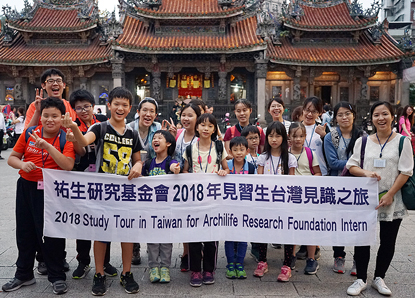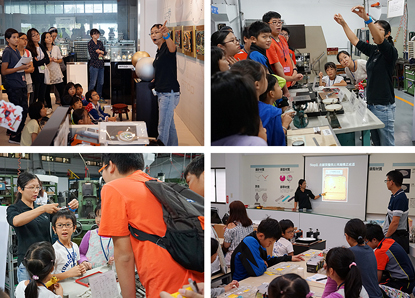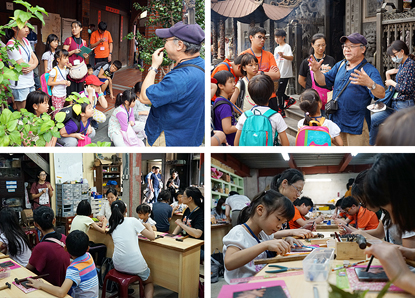Sketch of Archilife Study Tour, November 2018
|
2018年11月份見識之旅縮影  11月份見識之旅活動,於2018年11月18日由呂明澐小姐帶領22位祐生見習生及家長們,進行三峽老街文史巡訪暨一日金工鐵匠創作之旅。活動開始之初,領隊呂明澐小姐提醒本次活動注意事項及觀察重點,先行建立見習生的背景知識。 11月份見識之旅活動,於2018年11月18日由呂明澐小姐帶領22位祐生見習生及家長們,進行三峽老街文史巡訪暨一日金工鐵匠創作之旅。活動開始之初,領隊呂明澐小姐提醒本次活動注意事項及觀察重點,先行建立見習生的背景知識。For the study tour of November 18, 2018, Ms. Lu Ming-yun led 22 ARF interns and their parents on a tour to Sanxia Old Street to learn about its history and culture, and try their hands on creative metalwork. At the start of the day's activities, team leader Ms. Lu Ming-yun reminded everyone about things to note and what to observe, and gave the interns some background knowledge.  本次上午參訪王鼎時間科藝體驗館,行程一開始,導覽人員以日月山川為主題,解釋一天白晝黑夜輪轉及一年四季遞嬗的原因,讓見習生對地球自轉與公轉有基本印象。導覽人員隨即講述,我們能藉由觀察生物的痕跡(如年輪)、脈搏一分鐘跳動次數及食品保存期限等,來察覺時間與人的關係。現場亦鼓勵見習生透過鼻子嗅聞,比較新醋與陳年老醋之間的差異,利用五感感知生活周遭的事物,體會時間流逝。隨後說明世界時區係以格林威治標準時間為基礎,教導眾人簡單計算全球各區時差。緊接著,導覽人員配合館內展示之石英礦石、精密測量儀器及相關機具,講解石英錶轉動的原理,介紹錶芯大致的製造流程,其中更以測量零件厚度的儀器,量測見習生的頭髮厚度,表現出手錶零件的細密程度。 本次上午參訪王鼎時間科藝體驗館,行程一開始,導覽人員以日月山川為主題,解釋一天白晝黑夜輪轉及一年四季遞嬗的原因,讓見習生對地球自轉與公轉有基本印象。導覽人員隨即講述,我們能藉由觀察生物的痕跡(如年輪)、脈搏一分鐘跳動次數及食品保存期限等,來察覺時間與人的關係。現場亦鼓勵見習生透過鼻子嗅聞,比較新醋與陳年老醋之間的差異,利用五感感知生活周遭的事物,體會時間流逝。隨後說明世界時區係以格林威治標準時間為基礎,教導眾人簡單計算全球各區時差。緊接著,導覽人員配合館內展示之石英礦石、精密測量儀器及相關機具,講解石英錶轉動的原理,介紹錶芯大致的製造流程,其中更以測量零件厚度的儀器,量測見習生的頭髮厚度,表現出手錶零件的細密程度。The tour began with a visit to Atop Time Arts Pavilion in the morning. Using the sun, moon, mountains and rivers as the theme, the tour guides explained the reason for the cycle of day and night, and the four seasons each year, giving the interns some background understanding of the Earth's rotation and revolution. She said that we could perceive the relationship between time and people by observing the traces left by living things, e.g. tree ring, the frequency of beats per minute pulse rate and shelf life of foods. The interns were urged to smell the difference between new vinegar and old vinegar, and use their senses to learn about their surroundings and become aware of the flow of time. The tour guides then explained that time zones of the world are based on Greenwich Mean Time, teaching everyone the simple way to calculate time differences for places in the world. Referring to the quartz stone, precision measuring instruments and related equipment on display, the tour guides explained how a quartz watch works and the manufacturing process for its internal mechanism. In the process, the tour guides also used a thickness gauge to measure the thickness of interns' hair to show the degree of precision and intricacy of the parts and components of a watch.  中午飯後,由三角湧文化協進會人員蘇先生,以三峽老街為主軸進行導覽。首先導覽老師說明三峽藍染文化的起源與發展,介紹自植物「大菁」萃取藍染原料的步驟。因三峽地處大漢溪、三峽溪與橫溪匯流沖積而成的平原上,故舊稱「三角湧」,是當時茶葉、樟腦及染布重鎮,導覽老師特別教導如何從牌樓上的匾額,解讀其販售的商品,並針對老街上巴洛克式立面牌樓及紅磚拱廊建築的風貌做解說。隨後來到三峽祖師廟,該廟係由知名畫家李梅樹老師主持重修,廟內的雕刻除了講述傳統忠孝節義故事外,亦融合西方文化元素,兼容不同流派匠師的風格,有東方藝術殿堂的美譽。行程最後至打鐵人藝術工作坊,進行金工DIY活動。眾人皆是首次體驗金工DIY,雖然剛開始掌握不到敲打要訣,但漸入佳境,經過一番努力後,順利完成獨一無二的作品。至此,本日活動已近尾聲,大家一起合照留念後搭車返程,並期待於下次見識之旅再相見。 中午飯後,由三角湧文化協進會人員蘇先生,以三峽老街為主軸進行導覽。首先導覽老師說明三峽藍染文化的起源與發展,介紹自植物「大菁」萃取藍染原料的步驟。因三峽地處大漢溪、三峽溪與橫溪匯流沖積而成的平原上,故舊稱「三角湧」,是當時茶葉、樟腦及染布重鎮,導覽老師特別教導如何從牌樓上的匾額,解讀其販售的商品,並針對老街上巴洛克式立面牌樓及紅磚拱廊建築的風貌做解說。隨後來到三峽祖師廟,該廟係由知名畫家李梅樹老師主持重修,廟內的雕刻除了講述傳統忠孝節義故事外,亦融合西方文化元素,兼容不同流派匠師的風格,有東方藝術殿堂的美譽。行程最後至打鐵人藝術工作坊,進行金工DIY活動。眾人皆是首次體驗金工DIY,雖然剛開始掌握不到敲打要訣,但漸入佳境,經過一番努力後,順利完成獨一無二的作品。至此,本日活動已近尾聲,大家一起合照留念後搭車返程,並期待於下次見識之旅再相見。After lunch, Mr. Su from Sanchiaoyung Cultural Promotion Association led the group on a tour of Sanxia Old Street. Mr. Su began by describing the origin and development of indigo dyeing in Sanxia, and the procedure of extracting indigo dye from the assam indigo plant (Strobilanthes cusia). Located on the plain where the Dahan River, Sanxia River and Heng River meet, Sanxia was originally called "Sanchiaoyung", meaning the "delta of three rivers", and used to be an important trade town for tea leaves, camphor and dyed fabric. Mr. Su made a special effort to teach everyone how to interpret the signboards on the shophouses. Mr. Su also explained the architectural design of Baroque-style building and red brick archways. Arriving at Sanxia Zushi Temple, Mr. Su explained that the restoration of the temple was led by master painter Li Mei-shu. Sculptures within the temple depict stories of loyalty, filial piety, integrity and righteousness, and integrate elements of both Eastern and Western cultures, and combine styles of different craftsmen, giving the temple its reputation as the temple of Eastern arts. The final part of the tour brought everyone to participate in metalwork DIY activity. Although all the participants had difficulty grasping the hitting technique at first, they soon improved after making much effort and eventually completed their unique works. At this point, the day's itinerary came to an end. Everyone took a group photo before heading back and looked forward to the next study tour. |

